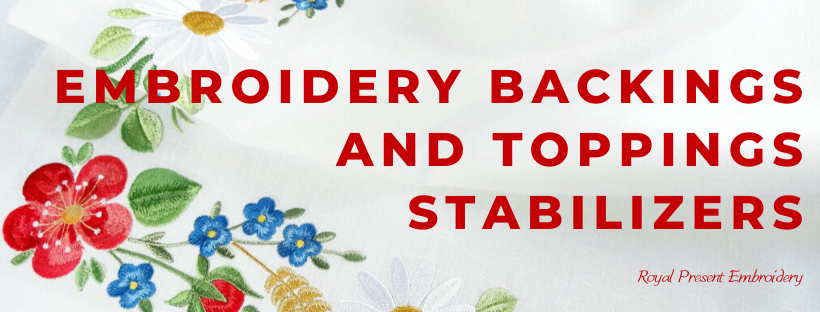Embroidery stabilizers’ nature and use
When mastering the notion of stabilizers’ use one should distinguish between its positioning in regard to the embroidered-to-be textile. The helping material could be place on top of the fabric (embroidery topping), or underneath it (embroidery backing). The main difference between them, besides placement regard, lays in the cause of the damage from which they are supposed to prevent. Usually toppings prevent the fabric texture from being distressed by the pressure of the thread being put through it, especially when stitches go deeper than needed in different types of textile (e.g. in velvet). Backings are helpful in keeping the fabric in place for better process of the stitching itself. Also afterwards, during washing or general wear, an embroidered piece will hold better its shape and look if it was worked on with the use of some kind of backing.
Embroidery Backings
Now that the meaning of this type of stabilizer is cleared, it is worthy digging further into the types of existing backings. They all are grouped by their adjoining to the fabric character. Some of them are “glued†to textile by different means. Others are just sewn on by threads of the design. While most of backings are usually removed after the design is embroidered, few of them remain permanently, at least partially. For the design to endure without harming the textile piece, role of each type is decisive.
Tear-aways (also called tear away backing)
It is fair to say that this type is most commonly used. It suits many kinds of textile (sturdy ones especially) and usually doesn’t demand much manipulation to be removed, because it is usually made of paper. Fabric, which is soft and stretchy (knitted one), is less agreeable with such backings. As the thickness of the type varies, bifold and even threefold uses of tear-away backing are possible for some designs.
Cut-aways (also known as a cut away backing)
This lot remains with the design even after the work is finished; prolonging thus lifespan of both the embroidery and the article it is applied to. They are very good fit for textile tending to get stretched with time and use, because of the flexible nature of the material they are made of (usually viscose nonwovens). Some cut-aways could be easily tautened forward, unlike others. If patterns call for such backing, plus need it to expand in all directions, than double cross-layering of cut-away stabilizer should be used. Two folds should be applied perpendicular to each others’ fiber lines. Tenor of fibers is meaningful because if applied wrongly, backings will spoil designs. Also quality of the backing is graded by its fibers’ arrangement. The odder the arrangement, the less is the bracing effect of the stabilizer.
The highest class of cut-ways is manufactured with addition of other special elements (cellulose and others). Different technique of production achieves unyielding material, which is very delicate to touch. One sheet of this backing suffices for any work. Additional virtue of this type is that it’s undetectable over textile. For additional grip on the fabric during embroidery process, some light glue or basting is used.
Some varieties of fabric have their favorites among cut-away backings. Poly Mesh (petted as No Show Mesh) just loves difficult pieces like knitted or transparent ones. It manages embroidery with just one layer support. All backings are manufactured with various consistencies. This one, plus to the density feature, has color choice of bigger range.
Types of backing which could be adhered by different kinds of glue (adhesive backings)
This backing is kindred to an ordinary stabilizer but is adhered to the needed textile piece by heat (through ironing); another variant is a stick on with one side being overlaid with special screen, in order for the glue side not to come in contact with environment at unwanted circumstances. The latter form of backing is commonly used for textiles or detail articles of clothing requiring delicate handling (e.g. velvet collars). The hoop should be put upon the stabilizer too, in order not to leave an imprint on the soft texture.
Backing, dissoluble in water.
The magical stabilizer is great solution for see-through textile and different kinds of openwork fabric. After the design is embroidered the backing disappears when the piece is put in water.
Solvent backing, not requiring water (aka fusible stabilizer)
“Unwashable†textile, which never should contact water and is at the same time too frail to be combined with other stabilizers, can be helped only by fusible backing. A good example of use of the kind is during work on edging lace, where open parts of the fine material could be seen from both sides. Such backing is shed with the help of heat (when ironing). As the fabric, calling for such a particular interfacing, cannot tolerate water, steam ironing programs must not be used here too.
Details on stabilizers used on upper side of textile (also called embroidery toppings)
These little utilities keep surface of particular textile from interfering in stitching process. They are helpful when embroidering furry fabrics, loosely knitted materials etc. Substance from which such stabilizers are made is water solvent (usually gelatin). Toppings of variant density are used depending on the fabric texture. If nature of textile prevents it from being water rinsed, than other types of toppings are used. Components of such toppings are manufactured in such a manner that heat can affect them in same way that water affects soluble ones. Again it is crucial to avoid steam ironing with such types, because the material could be damaged irrevocably.
What should be taken into account during process of stabilizer selection?
Having outlined main features of stabilizer types, it is worth giving general guideline to pairing certain stabilizers to some forms of textile.
Light stabilizer will never hold more substantial piece of textile, so consistency of both should match. However if the design of the embroidery that you choose is close knit (packed with stitches), sturdier interfacing is more handy. Some threads (ones containing metal) tend to up the temperature of the sewing needle during punching through, which can cause problems in the work. As a medium between the two, natural material, cushions the undesirable effect. Therefore when dealing with these particular yarns, stabilizers made of non-synthetic components should be preferred. Besides fabric substantiality, embroidery pattern consistency other factors must be measured. Machine characteristics must be remembered (speed of needlework and hoop size). Frame of the pattern, range of stitches and thread type are all to be counted for the project to look well and last through wear and washes.
You May Also Like
Embroidery Density, Stitch Count, Size

Author: Ludmila Konovalova
My name is Lyudmila Konovalova, and I lead Royal Present Embroidery. Embroidery for me is more than a profession; it is a legacy of my Ukrainian and Bulgarian heritage, where every woman in my family was a virtuoso in cross-stitch and smooth stitching. This art, passed down through generations, is part of my soul and a symbol of national pride.
Date: 24.05.2016




 Get Sign-In Link
Get Sign-In Link Login with Google
Login with Google Login with Facebook
Login with Facebook Login with Amazon
Login with Amazon Login with Paypal
Login with Paypal